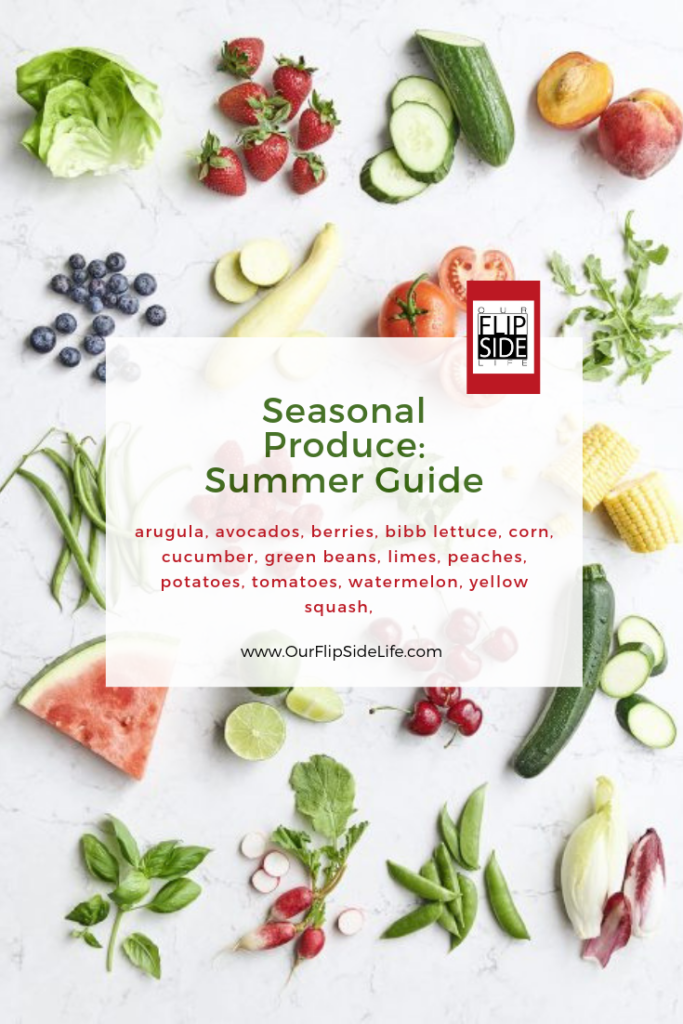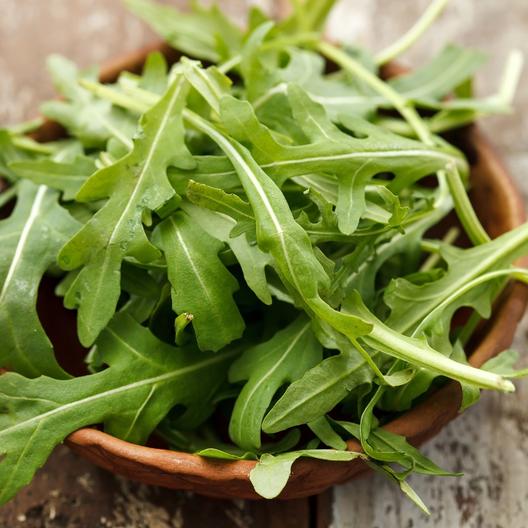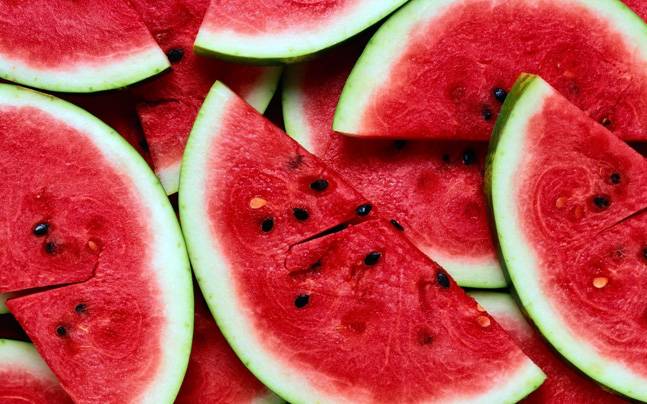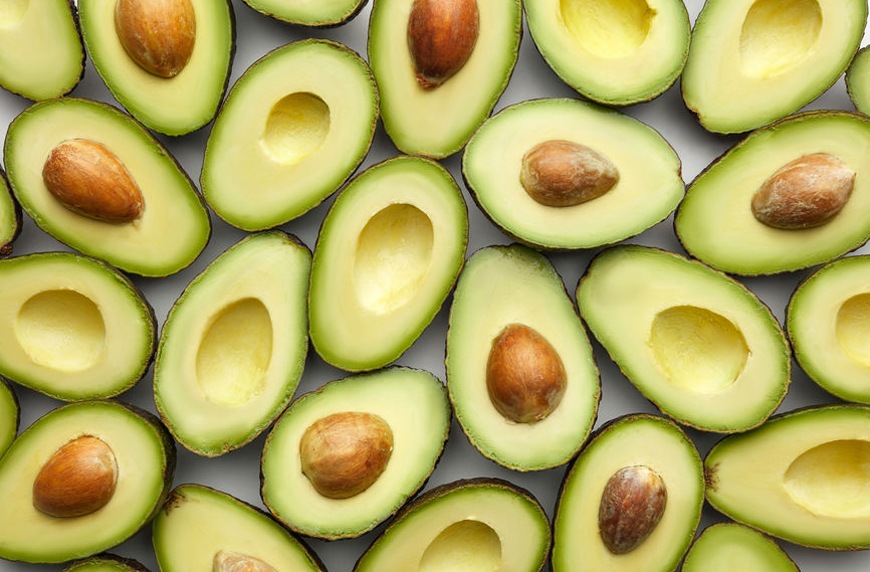
My Seasonal Produce: Summer Guide is a little late this year but better late than never, right?
Similar to last season’s Seasonal Produce: Spring Guide here’s a list of delicious fruits and veggies available right now. Eating seasonally provides amazing health benefits and keeps costs down so make sure to take full advantage!
Note: the list includes summer produce available in the New York metropolitan area this season. This includes: New York, New Jersey, Connecticut, Pennsylvania, and their principal cities. Make sure to check local listings for what’s growing in your area.

Seasonal Produce: Summer Guide
Arugula: One of my favorite leafy greens. Similar to spinach, arugula is versatile and easy to work with. Try using arugula in place of iceberg lettuce for extra nutrients and a different yet delicious peppery taste. Arugula is great raw or sautéed in salads, on sandwiches, with eggs, in pastas, and even as a basil substitute in pesto.
Avocados: This superfood is packed with healthy fat, fiber, vitamins and minerals. Add to salads, wraps, tacos, smoothies, even brownies for a healthy alternative to unhealthy oils. Don’t believe me? Check out this recipe for Avocado Brownies that will blow your mind.
Berries: Blackberries, blueberries, raspberries, and strawberries are in season now! Blueberries will give you the most nutritional bang for your buck because they’re high in antioxidants, fiber, and vitamin C. Enjoy berries as part of hearty breakfast or as a snack topped with Barney’s Chocolate Almond Butter and a sprinkle of cinnamon. My favorite!
Bibb Lettuce: A type of butter lettuce known for its loose, round-shaped heads of tender, sweet leaves and a mild flavor. Use it in place of tortillas in wraps for a low-carb option. Fun Fact: Bibb Lettuce was named after the man who first cultivated it in the 1860s, John Bibb.
Corn: Fresh, organic corn on or off the cob adds healthy fiber, niacin, phosphorous, potassium and vitamin A, as well as starch and protein to our diet. When corn is in season locally, you’ll likely find that it is freshest and most delicious, especially when you buy it at farm stands or farmers’ markets rather than at supermarkets. For more on corn, refer to on my previous post: Baked Polenta Fries.
Cucumber: Did you know cucumbers are10 to 20 degrees cooler than their surrounding environment because they’re mostly water? The same goes for watermelon. But they don’t like extreme cold, so avoid storing them in the chilliest part of your fridge. Add to salads for nutrients and a healthy crunch or enjoy as a snack with a smear of Kite Hill Chive Cream Cheese Alternative!

Green Beans: are most tender and sweet in summer. Look for bright, firm pods that break cleanly when snapped. They come in several varieties (string beans, Chinese long beans, flat green beans, and French green beans) and can be prepared in a variety of ways,. Microwave, roast, pressure cook, blanch and shock, or steam and sauté.
Limes: a citrus fruit, and excellent source of antioxidants that protect the body from free radicals. Limes are also anti-inflammatory and delicious in taste. Trying a drizzle over salads with olive oil and a pinch of salt, in soups, guacamole and favorite (low sugar) Summer cocktail! Anything goes!
Peaches: When shopping for peaches, look for ones that feel heavy, smell fragrant, are soft but not squishy. They’re best at room temperature, so if you store them in the fridge, let them warm up a bit before eating. Helpful Tip: just like avocados, you can ripen peaches by placing them in a paper bag.
Potatoes: There are so many varieties of potatoes, preparation methods, and flavors. We prefer purple potatoes for healthy antioxidants and rich flavor and chilled potatoes salads. For more on purple potatoes and the health benefits of starch resistance in chilled potatoes refer to my previous post: Health Benefits Of Purple Potatoes and Cooling Rice, Pasta and Potatoes After Cooking Increases Resistant Starch which can be beneficial to our health
Tomatoes: is one of summer’s darlings for a reason. They come in a multitude of varieties, from 2-pound beefsteaks to dainty cherry tomatoes. Look for ones that are fragrant and feel heavy, and don’t store them in your fridge as they can become flavorless and mealy. Healthy Tip: Tomatoes are consider a Nightshade which can cause inflammation in the body. Decrease the amount of tomatoes you consume this summer if you’re dealing with inflammation or have a sensitive stomach. For more on Nightshades refer to the post I recently shared on INSTAGRAM.
Watermelon: is sweet, crisp, and refreshing, and all we want it on a hot summer day. Look for ones that are firm, “heavy,” symmetrical, and unblemished. Watermelons pair well with herbal, sour, or sweet flavors like basil, mint, tomatoes, berries, lemon juice, feta, goat cheese, red onions, honey, lime, and sea salt. Aka: everything so enjoy!
Yellow Squash: is one of the many summer squashes available right now. Fun fact: Zucchini is also a summer squash, but unlike the summer squash, it is available year-round! Common among summer squashes, the yellow squash is picked young and tender and can be served raw or cooked. Enjoy in salads, soups or healthy breakfast omelets!

Where to buy Seasonal Produce:
Local online grocers: If you follow us on Instagram and Facebook you know we get our groceries delivered by a local, online grocer, Fresh Direct. Fresh Direct works with local farmers to bring us the best produce of the season. Unfortunately, Fresh Direct only services NYC. However, I encourage you to check your local listings for online grocers that offer locally sourced produce in your area.
Farmers Markets are a great place to shop for local produce and take advantage of special prices. Plus you can meet the farmers! Most farmers love talking about their harvest, offer samples of other produce they grow and share recipe tips which can be helpful especially if you’re not too familiar with the product. (joe and I like split up at the farmers market – I end up at the veggie and flower section while joe ends up chatting with the guys that make moon shine). J Make vising the Farmer’s Market a family affair. This is a great way to teach the kids about healthy eating. Carolina loves adding fruits and veggies into her bag and taking it to the check-out counter.
CSA (Community Supported Agriculture Program) or Farm Share: Farm shares are becoming quite popular (or at least popular for us). CSA or Farm Share commonly refers to a group whose members receive weekly shares of food from a certain farm (or groups of farms) in their region. Joe and I buy into different Farm Shares with Local Roots here in NYC. Our produce box will be ready for pick up on next week. I’m excited to share with you what the farmers grew for us and how we incorporate it in our recipes.
Takeaway
I hope this guide is helpful and encourages you to eat seasonally as often as possible. Remember that a healthy lifestyle is the best gift you can give yourself and your family.
I’ll leave you with related links that incorporate seasonal produce. Hope they serve as inspiration!
Related links: Mexican Street Corn Salad , Dairy-Free Scalloped Potatoes
Don’t forget to share your recipe photos by tagging them with the hashtag #OurFlipSideLife
¡Comer por temporadas brinda sorprendentes beneficios para la salud y mantiene bajos los costos, así que asegúrese de aprovechar al máximo todos los productos de verano que se consiguen ahora!
Nota: la lista incluye productos de verano disponibles en el área metropolitana de Nueva York esta temporada. Esto incluye: Nueva York, Nueva Jersey, Connecticut, Pensilvania y sus ciudades principales. Asegúrese de consultar las listas locales para saber qué está creciendo en su área.
Guia de Productos Disponibles en el Verano!
Rúcula: uno de mis vegetales de hojas favoritas. Similar a las espinacas, la rúcula es versátil y fácil de trabajar. Intente usar rúcula en lugar de lechuga iceberg para obtener nutrientes adicionales y un sabor a pimienta diferente pero delicioso. La rúcula es excelente cruda o salteada en ensaladas, en sándwiches, con huevos, en pastas e incluso como un sustituto de albahaca en pesto.
Aguacates: este superalimento está lleno de grasas saludables, fibra, vitaminas y minerales. Agregue a ensaladas, envolturas, tacos, batidos, incluso brownies para una alternativa saludable a los aceites no tan saludables.
Berries (o bayas): ¡Las moras, los arándanos, las frambuesas y las fresas están en temporada ahora! Los arándanos le darán el mayor beneficio nutricional por su dinero porque son ricos en antioxidantes, fibra y vitamina C. Disfrute de las bayas como parte de un desayuno abundante o como una merienda cubierta con mantequilla de almendras y una pizca de canela. ¡Mi favorito!
Lechuga Bibb: un tipo de lechuga mantequilla conocida por sus cabezas sueltas, redondas de hojas tiernas, dulces y un sabor suave. Úselo en lugar de tortillas en envolturas para una opción baja en carbohidratos. Dato curioso: Bibb Lettuce lleva el nombre del hombre que la cultivó por primera vez en la década de 1860, John Bibb.
Maíz: El maíz fresco y orgánico dentro o fuera de la mazorca agrega fibra saludable, niacina, fósforo, potasio y vitamina A, así como almidón y proteínas a nuestra dieta. Cuando el maíz está en temporada localmente, es probable que descubra que es más fresco y delicioso, especialmente cuando lo compra en puestos agrícolas o en mercados de agricultores en lugar de en supermercados.
Pepino: ¿Sabías que los pepinos son de 10 a 20 grados más fríos que su entorno porque son principalmente agua? Lo mismo vale para la sandía. Pero no les gusta el frío extremo, así que evite guardarlos en la parte más fría de su refrigerador. ¡Agregue a las ensaladas nutrientes y un crujido saludable!
Judías verdes: son más tiernas y dulces en verano. Busque vainas firmes y brillantes que se rompan limpiamente cuando se rompen. Vienen en varias variedades y se pueden preparar de varias maneras.
Limas: una fruta cítrica, y una excelente fuente de antioxidantes que protegen al cuerpo de los radicales libres. Las limas también son antiinflamatorias y tienen un sabor delicioso.
Melocotones: cuando compre melocotones, busque los que se sienten pesados, huelen fragante, son suaves pero no blandos. Son mejores a temperatura ambiente, así que si los guardas en el refrigerador. Sabías que al igual que los aguacates, puedes madurar los melocotones colocándolos en una bolsa de papel.
Papas: hay muchas variedades de papas, métodos de preparación y sabores. Preferimos las papas moradas para obtener antioxidantes saludables y un rico sabor y ensaladas de papas refrigeradas. Para obtener más información sobre las papas moradas y los beneficios para la salud de la resistencia al almidón en las papas refrigeradas, consulte mis publicaciones anteriores.
Tomates: Vienen en muchas variedades, desde tomates grandes de 2 libras hasta delicados tomates “cherry”. Busque los que sean fragantes y se sientan pesados, y no los guarde en su refrigerador, ya que pueden volverse insípidos y harinosos.
Sandía: es dulce, crujiente y refrescante, y todo lo que queremos en un caluroso día de verano. Busque unos que sean firmes, “pesados”, simétricos e inmaculados. Las sandías combinan bien con sabores herbales, agrios o dulces como albahaca, menta, tomates, bayas, jugo de limón, queso feta, queso de cabra, cebolla roja, miel, lima y sal marina.
Calabaza Amarilla: es una de las muchas calabazas de verano disponibles en este momento. Común entre las calabazas de verano, la calabaza amarilla se cosecha joven y tierna y se puede servir cruda o cocida. ¡Disfruta en ensaladas, sopas o tortillas saludables para el desayuno!
Dónde comprar productos de temporada?
Tiendas de comestibles locales: si nos sigue en Instagram y Facebook, sabe que recibimos nuestras compras en un supermercado local, Fresh Direct. Fresh Direct trabaja con agricultores locales para traernos los mejores productos de la temporada. Desafortunadamente, Fresh Direct solo brinda servicios a NYC. Sin embargo, le animo a que consulte sus listados locales de tiendas de comestibles en línea que ofrecen productos locales en su área.
Farmers Markets es un excelente lugar para comprar productos locales y aprovechar los precios especiales. ¡Además puedes conocer a los agricultores! A la mayoría de los agricultores les encanta hablar sobre su cosecha, ofrecer muestras de otros productos que cultivan y compartir consejos de recetas que pueden ser útiles, especialmente si no está muy familiarizado con el producto. Haga que visitar el mercado de agricultores sea un asunto familiar. Esta es una excelente manera de enseñar a los niños sobre una alimentación saludable. A Carolina le encanta agregar frutas y verduras en su bolso y llevarlo al mostrador de salida.
CSA (Community Supported Agriculture Program) o Farm Share: las acciones agrícolas se están volviendo bastante populares (o al menos populares para nosotros). CSA o Farm Share comúnmente se refiere a un grupo cuyos miembros reciben porciones semanales de alimentos de una determinada granja (o grupos de granjas) en su región. Nosotros nos unimos a un “Summer Farm Share” con Local Roots aquí en Nueva York. Nuestra primera caja de productos estará lista para ser recogida la próxima semana. Estoy emocionada de compartir con ustedes lo que los agricultores cultivaron para nosotros y cómo lo incorporamos en nuestras recetas.
Espero que esta guía sea útil y lo aliente a comer según la temporada con la mayor frecuencia posible. Recuerda que un estilo de vida saludable es el mejor regalo que puedes darte a ti y a tu familia.
No olvides compartir tus fotos de recetas etiquetándolas con el hashtag #OurFlipSideLife en INSTRAGRAM! Hasta la próxima!
